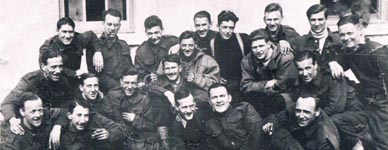|
The Glasbury Area at War - Involvement and Experiences This article was researched and written by Chris Forbes ( nee Lloyd ) |
| Charlie Lloyd was born in 1919 in Dowlais where his father had moved from Glasbury to find work in the mines. The family returned to Glasbury when Charlie was a baby, to live in the family home in Cwmbach. He attended Ffynnongynnydd primary school and Builth Wells County Grammar School and remained in Glasbury - apart from the war years - until his death in 1998. He met his wife, Mildred, at the beginning of April 1942 while home on leave just after the St Nazaire raid. She was working as a land girl at Maesllwch Castle. They married in August 1942. |
St Nazaire - 26th to 28th March, 1942
( The photo shows the survivors, with Charlie Lloyd on the right hand
side )
 My father enlisted in the Grenadier Guards on 7th November, 1939 at the age of 20. In 1941 he volunteered to join the Commandos and began intensive training in Scotland. In 1942, with Britain critically short of supplies and depending for survival on the convoys from America, the super-battleship Tirpitz was a major threat and the only dry dock large enough to house her, should she ever be damaged in battle, was in the French port of St Nazaire. Too precise a target for heavy bombers, this could only be destroyed by landing a force of men and explosives from the sea. This daunting and dangerous operation was entrusted to the commandos by Lord Louis Mountbatten and code named Operation Chariot. The force consisted of an obsolete and specially modified destroyer – HMS Campbeltown – whose bows were packed with explosives, and a fleet of Fairmile motor launches carrying the commandos. These launches were entirely unsuited to assault, being flimsy and at risk from fire, but had the advantage of being cheap to build (and therefore cheap to lose!). Approaching the port at the head of 2 columns of Fairmiles, the Campbeltown was to ram the outer gate of the dry dock and then scuttle herself, while the commandos were to storm ashore and do as much damage as they could to the rest of the port. They left Falmouth on 26th March, 1942 and arrived at the mouth of the Loire estuary just after midnight on 28th March. When challenged from the shore they pretended to be a German convoy returning to port and, flashing genuine German call signals provided by Intelligence, they confused the enemy long enough to penetrate close to their target. Then all hell let loose. Swept by fire from dozens of gun positions they immediately took casualties and several of the Fairmiles blew up when their petrol tanks were hit, while others took hits to their flimsy wooden hulls which forced them out of line. The river was a mass of burning boats and injured and dying men. However, due to the magnificent efforts of her captain, the Campbeltown hit her target, the dry dock gate, dead centre, at 01.34 hours and was hurriedly evacuated – a ticking time bomb. In the face of the heavy fire from the shore, only a handful of men were able to land. My father’s launch, number 156 was hit early. Disabled and forced to retire with her steering shot out, only one engine working fitfully, and with both naval officers as well as Hooper, their commander, wounded, it would have been suicide to go on. She was able to limp out to sea and rendezvous with the Atherstone which was waiting for the survivors, and then scuttled. Of the 611 soldiers and sailors who took part in Operation Chariot, 169 were killed and 200, most of whom were wounded, were taken prisoner. Only 242 returned immediately to British shores. When the ‘Campbeltown’ exploded the
following morning, carrying with her the massive outer gate of the
‘Normandie’ dock, the destruction for which so many
young men had sacrificed their lives, was finally complete. So well
had they done their job, the dock could not be used again before
war’s end. |